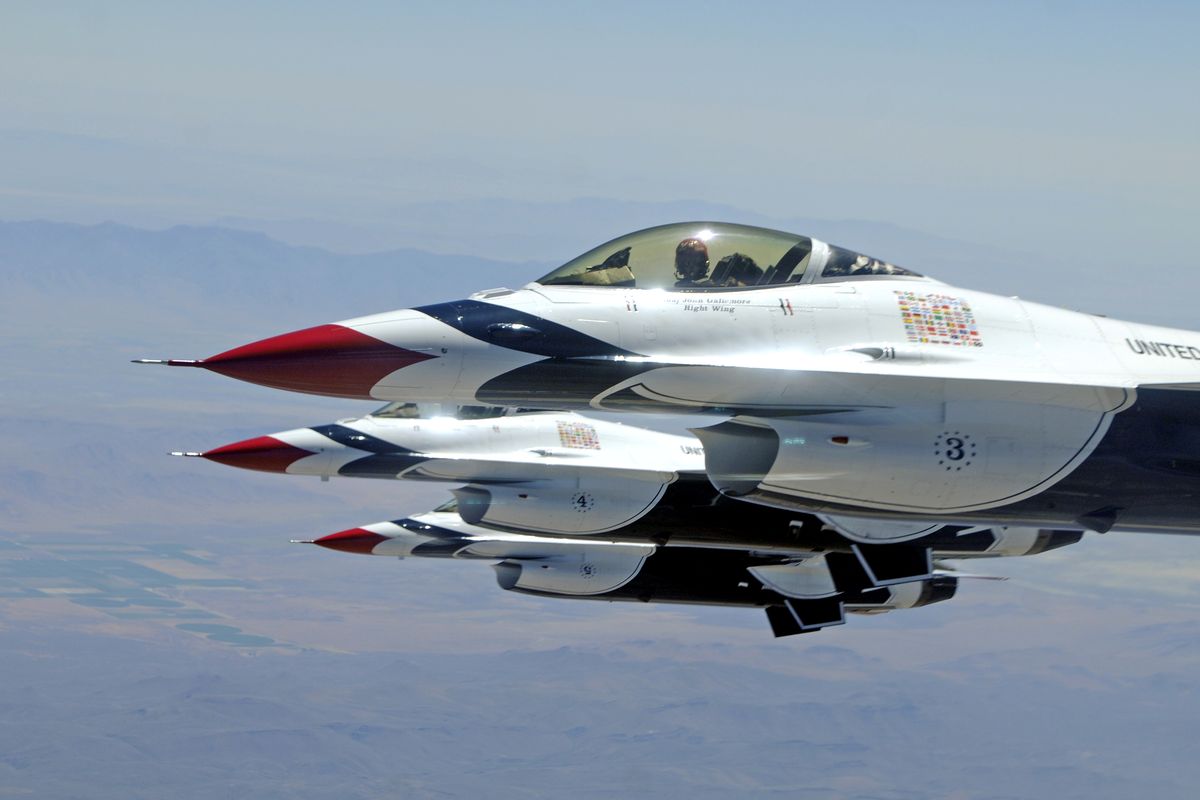Air Force Thunderbirds ready to wow at SkyFest

Thursday afternoon about 30,000 feet in the air over the caramel-colored plateaus and ridges of Nevada, a KC-135 Stratotanker from Fairchild Air Force Base had an important meeting, but the other party was a few minutes late.
The Stratotanker turned a sharp right above the barren landscape, counting down 11 miles, then 6, until the other party was in sight – the U.S. Air Force Thunderbirds.
At the high-altitude rendezvous, a fleet of Thunderbird planes hovered off both wings, waiting to be refueled in-air by the KC-135 to continue on their journey to Spokane for Fairchild’s annual air show, SkyFest.
It’s been four years since the Thunderbirds, the Air Force’s premiere aerobatics team, performed in the skies over Spokane. For pilot No. 6, this landscape is familiar.
“There’s something to be said for a homecoming,” said Capt. Aaron Jelinek, who attended Mead’s Midway Elementary School and later moved to Clarkston, Wash.
Jelinek is in his first season with the Thunderbirds, but has more than eight years of experience in a plane. His favorite maneuver: A cross-over break on his solo routine.
The Thunderbirds were activated in 1953 as the 3600th Air Demonstration Unit. The mission was to show off the best of what the Air Force had in the sky. Now they perform exclusively in air shows to demonstrate the ability of the planes and pilots, according to the Air Force.
The team flies the F-16 Fighting Falcon, which stands about 16 feet tall, and is about 50 feet long. Most of the planes were formerly used in air-to-air combat, and with minor changes became ready for air shows. The F-16 can travel at speeds of 1,500 miles per hour, Air Force officials said.
“It’s amazing to fly aircraft that can do anything,” Jelinek said of the F-16.
The squad consists of eight planes, but only six fly during a demonstration.
During a show, the team flies in a diamond formation, with as little as 18 inches of space between them. When the diamond formation converges with Jelinik and one other soloist, they are in Delta Formation, said Capt. Jason McCree, a spokesman for the Thunderbirds. McCree is also familiar with Spokane, having spent two years at Fairchild before a deployment overseas.
“I’m happy to be back,” he said. “This community is very welcoming.”
The KC-135 was the welcoming committee for the Thunderbirds, in the air at least. The plane’s purpose is to refuel aircraft in air that may not be able to land.
The refueling Friday was orchestrated by boom operators. The operator lies vertical in the tail of the plane, with a circuit board of gadgets and gauges, and a small window. The operator controls the refueling through the “ruddervator,” a joystick that lies right below the operator’s perch.
About 50 feet from the fueling boom, the pilot makes contact with the boom operator, who guides the pilot to a good position 2-3 feet from the receptacle. Then the operator must guide the boom over to fuel the plane, said boom operator Staff Sgt. Jason Grant.
Communication with the pilots of approaching planes, as well as the KC-135 pilots, is key, because “it’s inherently dangerous to have two aircraft in such close proximity,” Grant said.
The KC-135 can pump 895 gallons of fuel per minute to other planes, said Tech. Sgt. Gabe Ourso, who has operated fuel booms for 11 years.
In one minute the boom can pump enough fuel to run a vehicle for a year, Ourso said.